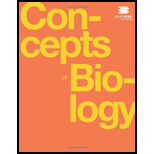
Concepts of Biology
1st Edition
ISBN: 9781938168116
Author: Samantha Fowler, Rebecca Roush, James Wise
Publisher: OpenStax College
expand_more
expand_more
format_list_bulleted
Textbook Question
Chapter 13, Problem 4RQ
Which of the following consist of prokaryotic cells?
a. bacteria and
b. archaea and fungi
c. protists and animals
d. bacteria and archaea
Expert Solution & Answer
Trending nowThis is a popular solution!

Students have asked these similar questions
What is the difference between Uniporters, Symporters and Antiporters? Which of these are examples of active transport?
What are coupled transporters?
What are “domains” and how do they aid in protein function?
Chapter 13 Solutions
Concepts of Biology
Ch. 13 - Figure 13.6 Which of the following statements is...Ch. 13 - The first forms of life on Earth were thought to...Ch. 13 - The first organisms that oxygenated the atmosphere...Ch. 13 - Which of the following consist of prokaryotic...Ch. 13 - Prokaryotes stain as Gram-positive or...Ch. 13 - Prokaryotes that obtain their energy from chemical...Ch. 13 - Bioremediation includes _____. a. the use of...Ch. 13 - What event is thought to have contributed to the...Ch. 13 - Mitochondria most likely evolved from_______. a. a...Ch. 13 - Protists with the capabilities to absorb nutrients...
Ch. 13 - Which parasitic protist evades the host immune...Ch. 13 - Which polysaccharide is usually found in the cell...Ch. 13 - What term describes the close association of a...Ch. 13 - Explain the reason why the imprudent and excessive...Ch. 13 - Your friend believes that prokaryotes are always...Ch. 13 - Describe the hypothesized steps in the origin of...Ch. 13 - How does killing Anopheles mosquitoes affect the...Ch. 13 - Without treatment, why does African sleeping...Ch. 13 - Why can superficial mycoses in humans lead to...
Additional Science Textbook Solutions
Find more solutions based on key concepts
1. Why is the quantum-mechanical model of the atom important for understanding chemistry?
Chemistry: Structure and Properties (2nd Edition)
Which type of cartilage is most plentiful in the adult body?
Anatomy & Physiology (6th Edition)
Why is an endospore called a resting structure? Of what advantage is an endospore to a bacterial cell?
Microbiology: An Introduction
1. ___ Mitosis 2. ___ Meiosis 3. __ Homologous chromosomes 4. __ Crossing over 5. __ Cytokinesis A. Cytoplasmic...
Microbiology with Diseases by Body System (5th Edition)
5. The diploid number of the hypothetical animal Geneticus introductus is 2n = 36. Each diploid nucleus contain...
Genetic Analysis: An Integrated Approach (3rd Edition)
What is the difference between cellular respiration and external respiration?
Human Physiology: An Integrated Approach (8th Edition)
Knowledge Booster
Learn more about
Need a deep-dive on the concept behind this application? Look no further. Learn more about this topic, biology and related others by exploring similar questions and additional content below.Similar questions
- What are intrinsically disordered proteins, and how might they be useful for a living system?arrow_forwardWhat are Amyloid Fibrils? What biological functions are these known to perform?arrow_forwardHow do histamine and prostaglandins help in the mobilization of leukocytes to an injury site? What are chemotactic factors? How do they affect inflammation process?arrow_forward
- Compare and contrast neutrophils and macrophages. Describe two ways they are different and two ways they are similar.arrow_forwardDescribe the effects of three cytokines (not involved in the initial inflammation response). What cells release them?arrow_forwardDescribe activation of helper T cells or cytotoxic T cellsarrow_forward
- Compare and contrast MHC 1 and MHC 2. Describe two way they are different and two ways they similar including how they are used in antigen presentation.arrow_forwardDescribe two antimicrobial properties of the skin.arrow_forwardDescribe how the inflammation response starts including the sentinel cells and the chemicals involved. How do pathogens trigger the response particularly in the skin?arrow_forward
- How does complement promote the immune response? Describe three waysarrow_forwardWhich of the following is not a possible mechanism for autoimmunity? Select one: A. Abnormal expression of MHC II molecules in non-antigen-presenting cells B. Activation of polyclonal B cells C. Polymorphism of HLA alleles D. Molecular mimicry E. Release of sequestered antigensarrow_forwardWRITTEN WORK 3: NON-MENDELIAN GENETICS Part A: Complete the Punnett square and calculate for the probability of genotype and phenotype. i i Genotype: Phenotype: 08:55arrow_forward
arrow_back_ios
SEE MORE QUESTIONS
arrow_forward_ios
Recommended textbooks for you
 Concepts of BiologyBiologyISBN:9781938168116Author:Samantha Fowler, Rebecca Roush, James WisePublisher:OpenStax College
Concepts of BiologyBiologyISBN:9781938168116Author:Samantha Fowler, Rebecca Roush, James WisePublisher:OpenStax College

Concepts of Biology
Biology
ISBN:9781938168116
Author:Samantha Fowler, Rebecca Roush, James Wise
Publisher:OpenStax College
Prokaryotic vs. Eukaryotic Cells (Updated); Author: Amoeba Sisters;https://www.youtube.com/watch?v=Pxujitlv8wc;License: Standard youtube license